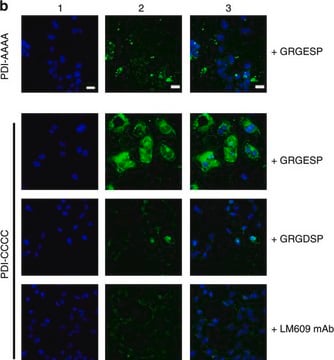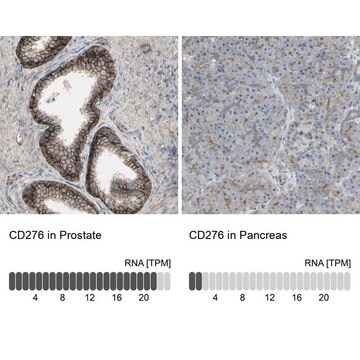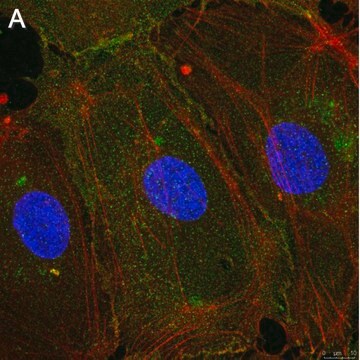詳細
We are committed to bringing you greener alternative products, which adhere to one or more of The 12 Principles of Green Chemistry.This antibody is Preservative-free, produced without the harm or sacrifice of animals and exceptionally stable to allow for ambient shipping and storage if needed and thus aligns with "Waste Prevention", "Designing Safer Chemicals" and "Design for Energy Efficiency".
Click here for more information.
ZooMAb® antibodies represent an entirely new generation of recombinant monoclonal antibodies. Each ZooMAb® antibody is manufactured using our proprietary recombinant expression system, purified to homogeneity, and precisely dispensed to produce robust and highly reproducible lot-to-lot consistency. Only top-performing clones are released for use by researchers. Each antibody is validated for high specificity and affinity across multiple applications, including its most commonly used application. ZooMAb® antibodies are reliably available and ready to ship when you need them.
特異性
Clone 1I17 is a ZooMAb® rabbit recombinant monoclonal antibody that specifically detects cellular nucleic acid-binding protein (CNBP). It targets an epitope within 23 amino acids from the N-terminal region.
免疫原
KLH-conjugated linear peptide corresponding to 23 amino acids from the N-terminal half of human cellular nucleic acid-binding protein (CNBP).
アプリケーション
Quality Control Testing
Evaluated by Western Blotting in L6 cell lysate.
Western Blotting Analysis: A 1:10,000 dilution of this antibody detected CNBP in L6 cell lysate.
Tested Applications
Western Blotting Analysis: A 1:10,000 dilution from a representative lot detected CNBP in lysates from HeLa and, SHSY-5Y cells and Mouse brain tissue lysate.
Western Blotting Analysis: !:1,000 dilution of this antibody detected CNBP in lysates from Mouse bone marrow derived macrophages, A549 cells, Human monocyte derived macrophage primary cells, Human monocyte derived macrophage primary cell nuclear extract, Mouse bone marrow derived macrophage from CNBP knockout mice, and A549 with CNBP knocked out . (Data courtesy of Dr Kate Fitzgerald′s lab at the University of Massachusetts Chan Medical School).
Immunohistochemistry (Paraffin) Analysis: A 1:100 dilution from a representative lot detected CNBP in Human kidney tissue sections.
Immunocytochemistry Analysis: A 1:1,000 dilution from a representative lot detected CNBP in Neuro2A cells.
Affinity Binding Assay: A representative lot of this antibody bound CNBP peptide with a KD of 3.9 x 10-9 in an affinity binding assay.
Immunoprecipitation: A representative lot of this antibody immunoprecipitated CNBP from lysate from A549 cells. ((Data courtesy of Dr Kate Fitzgerald′s lab from the University of Massachusetts Chan Medical School).
Note: Actual optimal working dilutions must be determined by end user as specimens, and experimental conditions may vary with the end user.
ターゲットの説明
CCHC-type zinc finger nucleic acid binding protein (UniProt: P62633; also known as Cellular nucleic acid-binding protein, CNBP, Zinc finger protein 9) is encoded by the CNBP (also known as RNF163, ZNF9) gene (Gene ID: 7555) in human. CNBP is a single-stranded DNA-binding protein with seven CCHC-type zinc-finger domains. It preferentially binds to the sterol regulatory Element™ (SRE) sequence 5′-GTGCGGTG-3′, and thereby mediates transcriptional repression. It also binds to single-stranded RNA in a sequence-specific manner. Arginine methylation by Protein arginine methyltransferase 1 (PRMT1) in its Arg/Gly-rich region impedes its RNA binding. It is reported to associate with the 40S ribosomal subunit, the 80S ribosome, and with polysomes. Its expression is observed in the liver, kidney, spleen, testis, lung, muscle, and adrenal glands and its expression is transcriptionally up-regulated by sterol treatment. Isoform 1 of CNBP is shown to bind to G-rich elements in target mRNA coding sequences and it prevents G-quadruplex structure formation in vitro, indicating its role in supporting translation by resolving stable structures on mRNAs. Mutations in CNBP gene have been linked to Dystrophia myotonica 2 (DM2), a multisystem disease that is characterized by the association of proximal muscle weakness with myotonia, cardiac manifestations, and cataract. Eight isoforms of CNBP have been described that are produced by alternative splicing. This ZooMAb® recombinant monoclonal antibody, generated by our propriety technology, offers significantly enhanced specificity, Affinity™, reproducibility, and stability over conventional monoclonals. (Ref.: Benhalevy, D., et al (2017). Cell Rep. 18(12); 2979-2990; Wei, H-M., et al. (2014). FEBS Lett. 588(9); 1542-1548; Rajavashisth, TB., et al. (1989). Science. 245(4918); 640-643).
物理的形状
Purified recombinant rabbit monoclonal antibody IgG, lyophilized in PBS with 5% Trehalose, normal appearance a coarse or translucent resin. The PBS/trehalose components in the ZooMAb formulation can have the appearance of a semi-solid (bead like gel) after lyophilization. This is a normal phenomenon. Please follow the recommended reconstitution procedure in the data sheet to dissolve the semi-solid, bead-like, gel-appearing material. The resulting antibody solution is completely stable and functional as proven by full functional testing. Contains no biocide or preservatives, such as azide, or any animal by-products. Larger pack sizes provided as multiples of 25 µL.
再構成
300 µg/mL after reconstitution at 25 µL per vial. Please refer to guidance on suggested starting dilutions and/or titers per application and sample type.
保管および安定性
Recommend storage of lyophilized product at 2-8°C; Before reconstitution, micro-centrifuge vials briefly to spin down material to bottom of the vial; Reconstitute each vial by adding 25 µL of filtered lab grade water or PBS; Reconstituted antibodies can be stored at 2-8°C, or -20°C for long term storage. Avoid repeated freeze-thaws.
その他情報
Concentration: Please refer to the Certificate of Analysis for the lot-specific concentration.
法的情報
Affinity is a trademark of Mine Safety Appliances Co.
Element is a trademark of Corning, Inc.
ZooMAb is a registered trademark of Merck KGaA, Darmstadt, Germany
免責事項
Unless otherwise stated in our catalog or other company documentation accompanying the product(s), our products are intended for research use only and are not to be used for any other purpose, which includes but is not limited to, unauthorized commercial uses, in vitro diagnostic uses, ex vivo or in vivo therapeutic uses or any type of consumption or application to humans or animals.










